A self-cleaning oven can help you keep your kitchen spotless. However, the unpleasant smell that sometimes accompanies the self-cleaning process can leave you wondering if it’s worth the hassle. In this guide, we’ll look at the mystery of the self-cleaning oven scent and how to deal with it efficiently.
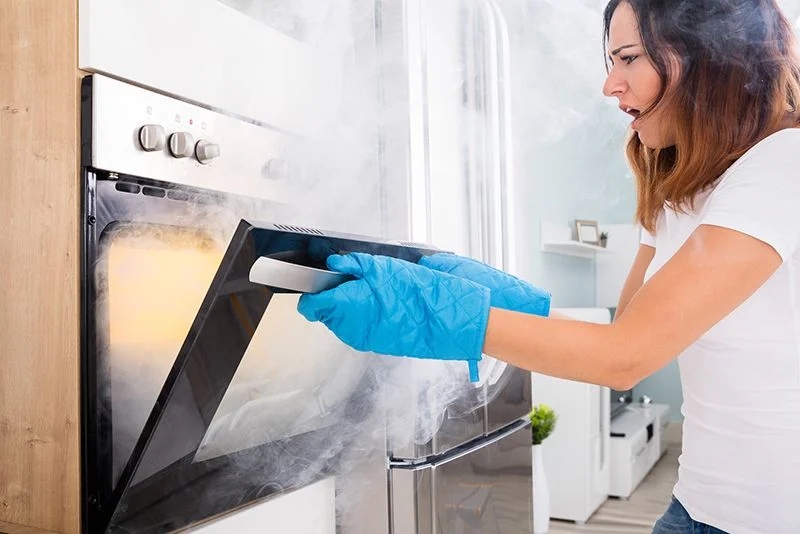
How Do Self-Cleaning Ovens Work?
Self-cleaning ovens feature a unique pyrolytic cleaning procedure. Here, the oven gets up to a scorching 800 to 900 degrees Fahrenheit, turning any leftover food and any spills into ash. They are likewise designed for safe use, but expect some smoke and stink from your oven.
Why Does Self Cleaning Oven Smell?
While self-cleaning is certainly convenient, it can also emit an unpleasant stink. The burning of food particles and grease that have accumulated in the oven over time is what produces this odor. As the oven heats up, these particles combust, emitting a wide range of compounds into the air, some of which have a pungent, smoky, or even burnt plastic-like fragrance. Improper ventilation can produce carbon monoxide buildup, resulting in odors and health problems.
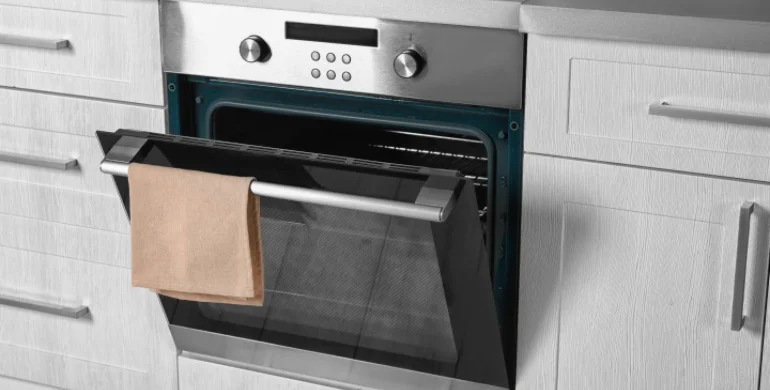
How to Get Rid Of Self Cleaning Oven Smell?
Fortunately, there are a number of tried-and-true methods for reducing or doing away with the odor of a self-cleaning oven:
- Open Windows and Doors: Before you begin the self-cleaning cycle, make sure you open all of the windows and doors in your kitchen and surroundings. This allows for proper airflow and aids in the dissipation of scents as they arise.
- Use an Oven Cleaner: If the scent continues after the self-cleaning cycle, consider using a commercial oven cleaner. These cleaners are intended to break down tough residues and eliminate odors.
- Baking Soda and Vinegar: In a bowl, combine equal parts baking soda and vinegar, then set in the oven while it is still heated. The chemical reaction between these two components will help to eliminate any leftover scents.
- Lemon or orange peels: The zesty scent of lemon or orange peels might help cover the odor of the self-cleaning oven. Simply arrange some fresh peels on a baking sheet and put them in the oven once the cycle is finished.
Self Clean Feature Benefits
Cleaning commercial ovens by hand can be time-consuming, hazardous, and ineffective. Here are the main benefits of employing the self-cleaning model:
- Reduced labor: With a self-cleaning oven, you may start a wash cycle in a matter of seconds. Any employee can set it and forget it, just like a dishwasher, giving them more time to focus on other duties or go home at night.
- Improved Safety: Features such as an automatic grease collecting system speed the cleaning process while reducing safety risks. Grease is much safer to dispose of in a portable jug, and there is no need to de-grease and clean the oven by hand.
- Thorough Cleaning: The high temperatures reached during the cycle ensure that even the most stubborn baked-on stains are successfully removed.
- Less Energy Usage: When compared to cleaning with continuous high heat, the self-clean cycle uses less energy.
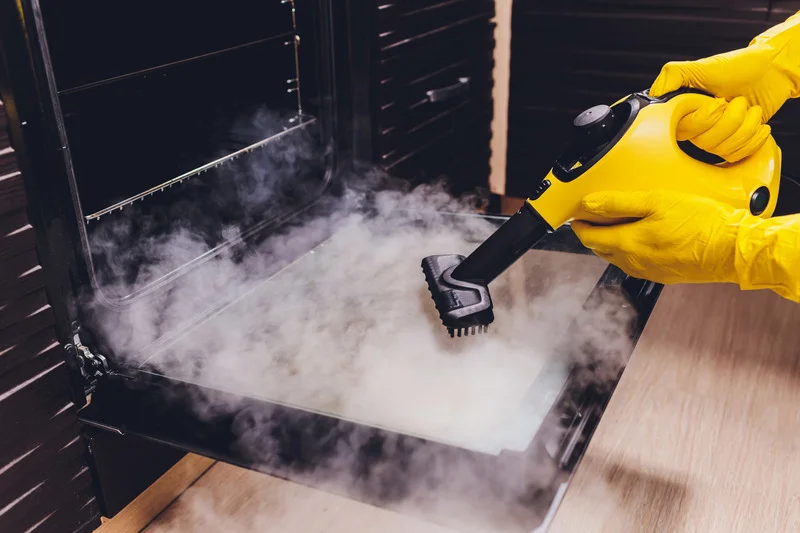
What are the Dangers of a Self-Cleaning Oven?
While self-cleaning ovens are generally safe when used correctly, there are a few potential dangers to be aware of:
Overworking the Oven
While cleaning, self-cleaning ovens reach temperatures of 900°F or greater, which might damage specific parts of the oven. These temperatures, for example, can cause damage to door seals, heating elements, and nonstick cookware coatings.
Also, the oven’s high temperature could bend or melt metal parts inside. As a result, it is critical to guarantee that only materials capable of withstanding such temperatures are left in the oven throughout the self-cleaning procedure.
Causing a Fire
When ovens employ their self-cleaning feature, they can reach temperatures as high as 800 or 900 degrees Fahrenheit—more than enough to start a house fire!
The extremely high temperatures in the oven might cause any substance left on top to catch fire, which could have disastrous results.
As an added fire risk, excessive temperatures can cause heating components or fuses to burn out, resulting in a costly repair and another fire hazard.
Fumes from the Oven
As the self-cleaning process progresses, the combustion of food and grease emits a cocktail of harsh chemicals. These pollutants circulate in the indoor air and can harm home inhabitants. When inhaled, these caustic particles can cause significant discomfort and, in extreme circumstances, longer-lasting medical complications.
Carbon Monoxide Risk
According to research, many self-cleaning ovens emit carbon monoxide into the kitchen and home. Carbon monoxide is a colorless, odorless gas with potentially dangerous side effects such dizziness, nausea, and lightheadedness. In severe circumstances, it may potentially result in death owing to oxygen starvation in the body.
If you plan to use your oven’s self-cleaning feature, make sure the room is well ventilated or, better yet, have a carbon monoxide monitor fitted in case of an emergency. These easy steps can help you stay safe while using a self-cleaning oven!
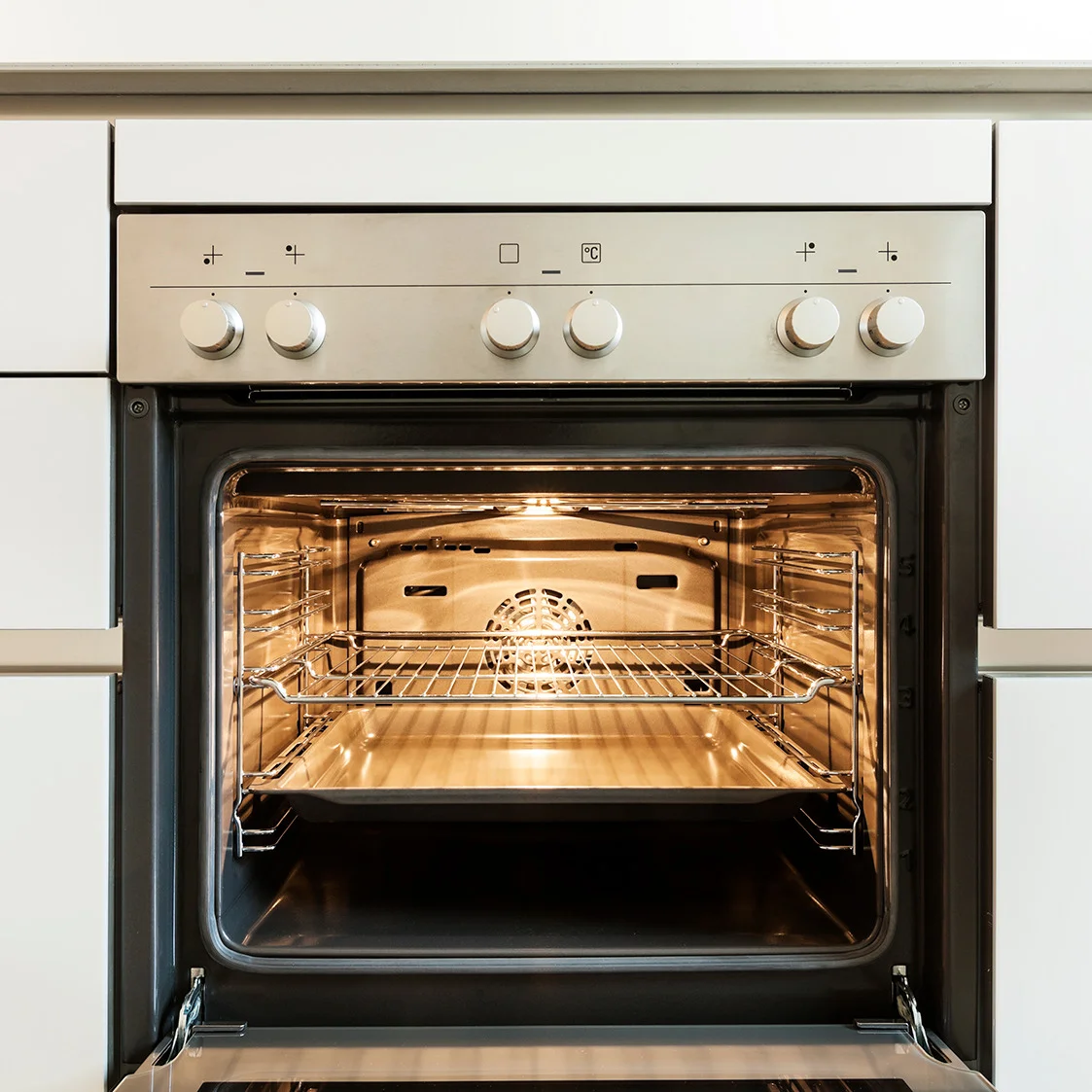
How Often Should You Clean Your Oven?
How often you clean your oven depends on a number of things, like how often you use it and what you cook in it. As a general guideline, run the self-cleaning cycle every three to six months, or whenever you notice a large buildup of filth and residue inside your oven.
Best Times to Self Clean Your Oven
How you time the self-cleaning cycle of your oven is really important. Here are some suitable times to consider:
- After a Large Meal or Holiday: Holidays such as Thanksgiving and Christmas sometimes entail a lot of cooking, making it an ideal opportunity to clean up any spills or messes.
- Spring Cleaning: Include oven cleaning in your annual spring cleaning regimen for a fresh start to the season.
- When the oven is already warmed: If you’ve just finished baking or roasting, the oven is already warm, making self-cleaning easier.
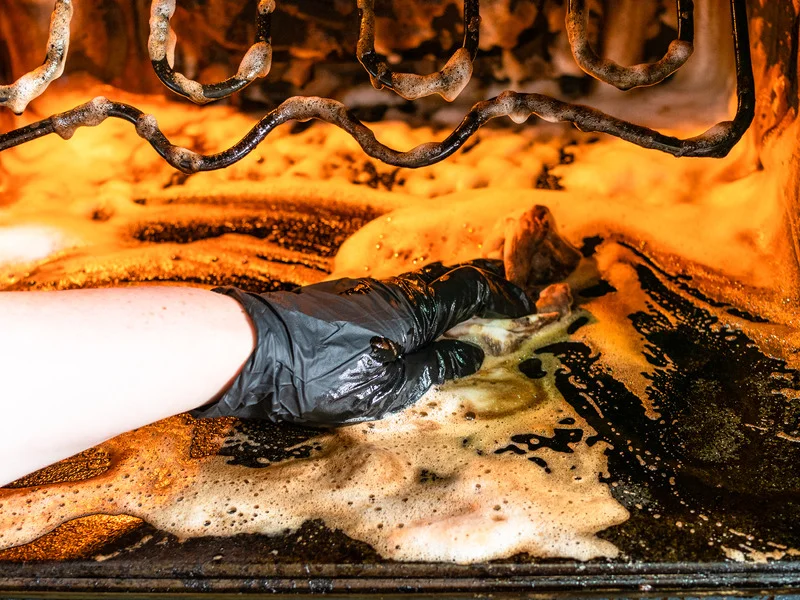
How to Use a Self-Cleaning Oven
1. Prepare the Oven for Cleaning.
To prevent damage, remove any loose items such as oven racks, the broiler pan, all cookware, foil, and any plastic on the range cooktop.
Using a moist cloth, wipe down the inner walls and door to eliminate any stray particles.
Check the owner’s manual for detailed information on how to prepare your oven model.
2. Run the Self-clean Cycle.
Locate the self-clean button or option on the oven’s control panel. Make sure the door is completely closed or else the cycle will not start. Set your chosen cleaning time and temperature, which is usually between 2-4 hours at high heat.
To provide appropriate airflow, open windows and doors.
3. Wait for the Oven to Cool Completely.
Do not open the oven door until the self-cleaning cycle is complete and the oven has cooled completely. You should be able to interrupt the cycle at any moment by pressing “Cancel” or something similar. However, the oven will remain locked until it has cooled. This process may take several hours, so be patient.
4. Wipe Down the Oven Interior.
After the oven has cooled, use a moist cloth or sponge to remove any leftover ash or residue. If scrubbing is required, use only mild, non-abrasive cleaners such as dish soap and water, vinegar diluted in water, or other cleaning solutions specified in your owner’s manual. It is generally not advised to use commercial chemical cleaners.
Conclusion
Dealing with the self-cleaning oven scent does not have to be a difficult process. You can enjoy a fresh and inviting kitchen environment by understanding how self-cleaning ovens function, why they release scents, and how to eliminate them effectively. Remember to keep a regular cleaning schedule and take safety steps to get the most out of your self-cleaning oven while reducing dangers. Happy cooking and happy cleaning!

FAQs
Oven odors are normal during self-clean and with a new unit. The odors are not toxic.
Pour a litre of water into a baking dish and add 1 cup of vinegar to the mixture. Preheat the oven to 200°C and place the dish on the lowest rack. Leave the water to boil in the oven for around an hour. Water will evaporate and absorb the smells in the process.
When exposed to 600 degrees Fahrenheit – or higher – during the oven cleaning, well, the off-gassing is very toxic to humans, especially babies, young children and pregnant women. The fumes can also cause flu-like symptoms, sweating, coughing and trigger asthma.
First and foremost, don’t leave your oven unattended during self-cleaning. You should plan to be in your home for the entire duration of the cleaning cycle to keep an eye on it and make sure everything is operating as planned. The next most important rules for oven self-cleaning involve ventilation.
Turning a unit off during self-clean is discouraged. Damage can occur if self-clean does not complete. If canceled or interrupted, the door stays locked until the unit cools to a safe temperature level. The amount of time it takes for the oven to cool to a safe level varies.
Sources:
- Clean but Smelly: Why Do Self-Cleaning Ovens Smell So Bad?
- What are the Dangers of a Self-Cleaning Oven?
- 5 Dangers of Self-Cleaning Ovens
- Is it Dangerous to Use Your Oven’s Self Clean Feature?
- What Causes That Bad Self-Cleaning Oven Smell?
- Wolf Oven Smokes and Odor during Self-Clean
- Is Your Self Cleaning Oven Dangerous?
- Is It Safe to Run Your Oven’s Self-Clean Cycle?
- Why You should NOT use Self-Cleaning Oven Feature
- Oven Odor After Self-Clean
- How does a self-cleaning oven work & how do you use it?
- How to Clean a Self-Cleaning Oven in 4 Steps
- Five Myths about Self Cleaning Ovens
- Safety and Chemistry of the Self-Cleaning Oven
- Why Does Your Self-Cleaning Oven Smell Bad?
- Yes, there are safety concerns with using the self-cleaning feature on an oven
- How to Clean a Self Cleaning Oven
- Here’s Why You Shouldn’t Use Your Oven’s Self-Cleaning Function
- Experts Warn Against Using the Self-Cleaning Feature on Your Oven—Here’s Why
- Self-Cleaning Oven Smell: Causes & Odor Reduction Tips
- How to Use the Self-Cleaning Oven Function Correctly
- I have a new GE double oven that I used the self cleaning…
- What You Need to Know Before Starting Your Oven’s Self-Cleaning Cycle
- How to Use the Self-Cleaning Mode on Your Oven